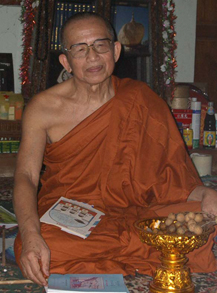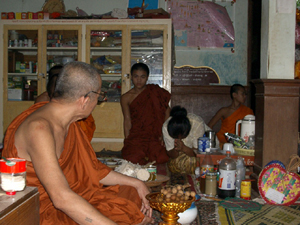|
“Master of Dharma” We returned to the temple in Myanmar, to meet the most venerable monk in the Shan State. This Master of Dharma was dressed in a dark brown robe that was unlike the usual saffron (bright orange) and deep red robes. Two young novices quietly listened off to the side. Khemacari was very friendly and seemed to be joyously happy or well fed while he initiated conversation with us. KHEMACARI: How many of you are there?
ANDY: Eleven. KHEMACARI: Where are you from? ANDY: America. KHEMACARI: I was in America 7 years ago. I visited Washington state, California and Mexico. ANDY: What did you think of it? KHEMACARI: Very good. Very convenient. ANDY: We really like your country as well. KHEMACARI: I am almost 80 years old. ANDY: What’s your position? What do you do at the temple? KHEMACARI: I have the highest monk position in the Shan State. Have you ever been here before? ANDY: This is our first time. What are the responsibilities of the highest monk? KHEMACARI: I distribute work into different areas in the district. I teach Buddhism in area schools in the Shan State and Buddhist colleges. ANDY: How long have you been a monk? How long have you been in your position? KHEMACARI: I’ve been a monk since I was ten years old, for about 67 years. When I was 10 years old, I was a novice. When I was 20, I became a monk. When I was 30, I became an abbot and a <prasawati>. When I was over 35 years old, I had another position called <pratsawami>. And when I was over 40, I became a <prakrubha>. And then, five years ago, when I was 72, I reached the highest position, and it’s called <somdet achayatam>. (This is also called “Master of Dharma”) Buddhism has been around for over 2000 years. Every 10 years, I was promoted to a higher position. ANDY: You’re already in the highest position… Are there none higher? KHEMACARI: There is another position. There is a higher position, the highest position. Even though I am the highest person in the Shan State, there is still a position that is higher. ANDY: What position is that? KHEMACARI: I must be over 80 to reach that position. ANDY: Since you’ve been a monk for such a long time, we were wondering if you could answer some questions we had about Buddhism? KHEMACARI: In heaven, there are 6 levels. If you use all the merit you’ve accumulated on earth, you have to come back to earth to earn merit again. If you have enough merit in heaven, you don’t have to come back on earth. You can go straight to nirvana.
KHEMACARI: Yes. ANDY: Did Buddha have to become a spirit first before going to nirvana? KHEMACARI: No, he didn’t have to be a spirit to go to nirvana. ANDY: One monk in Mae Hong Son told us Buddha had to become a spirit first to go to nirvana. KHEMACARI: That’s not right. ANDY: Do you get to nirvana by knowledge or by merit? KHEMACARI: By doing good deeds, making merit, keeping the teaching, and reciting prayers. So there are three things: 1. Make merit, 2. Follow the teachings, 3. Prayer. . Making merit is like a business. In a business, you have to make money in order to spend money. Merit is the same. If you run out of merit, you have to make more. ANDY: Who do you pray to? KHEMACARI: We pray to ourselves. We think of nothing. We try to get out everything that makes us worried about the world. Breathe in, breathe out. Breathe in, breathe out to get everything out. ANDY: What happens after you get to nirvana? KHEMACARI: There’s nothing in nirvana. No birth, no death, no sickness, no suffering. ANDY: Do you think you’re going to nirvana after you die? KHEMACARI: If I try to keep the teachings. ANDY: But do you believe that you will go to nirvana? KHEMACARI: I try my best to keep the teachings. If I see something dirty, then I try to wash it, and wash it. ANDY: Do you have assurance? KHEMACARI: I put forth my best efforts in order to go there. But if it’s impossible in this life, I will try in the next life. It’s like there are 3 guys working together. If one guy can’t complete the work, then the second guy must try to complete the work. Likewise, if the second guy can’t finish the work, then the third guy must try to complete it… (He is making a parallel between the guys and the cycle of rebirth.) I also try to leave all things behind with the hope that one day I’ll go to nirvana. ANDY: What are the women doing in that other room? KHEMACARI: They are making merit by offering food and goods to monks here. They believe this merit will go to their parents and ancestors that have passed away. So children still on earth can get merit for them, but also the merit goes to themselves. ANDY: So children can make merit for their parents and ancestors, and can also make merit for themselves. KHEMACARI: Yes. ANDY: So another person can make merit for someone else and you can share merit? KHEMACARI: Yes. [Khemacari then hands us a blue book called The Khun Reader that he tells us we can study. He states that he’ll give each of us a copy.] ANDY: What is this? A book of chants? KHEMACARI: It will teach you how to read and write Tai Khun. ANDY: Who is merit given to? Where does merit go? KHEMACARI: Sin, heaven and merit cannot be seen. I don’t know who the giver is. It’s like a mango tree. You can see the fruit in season, but out of season, you can’t find the mango. Even if you were to cut open the tree, you still wouldn’t be able to find the mango until the season comes. [He is essentially saying he doesn’t know where merit comes from.] ANDY: Do Shan use tattoos to keep spirits away? KHEMACARI: The amulet only protects people from knives, guns, things like that. Tattoos exist to keep people away from guns, knives. Amulets keep spirits away. Amulets have many uses. ANDY: How do they protect from gunshots and knives? KHEMACARI: For guns, it won’t let the bullet come out of the gun. For knives, it won’t cut you; it makes it blunt. ANDY: How does the tattoo or amulet have power in order to not let that happen? KHEMACARI: The power is from the thing: the amulet and tattoos. Thousands of years ago, there were people who lived in the jungles. These people would pray, cut herbs, and blend colors to make tattoos. But not many people do it now because it hurts. Good people don’t need it. Only bad people who want to do evil need them.(At that point Khemacari had to go to eat in order to finish his meal before noon. We thanked him for his time and insight. He invited us to come again.) [This interview was conducted in July, 2003.]
|




 ANDY: Do you have to become a spirit first before going to nirvana?
ANDY: Do you have to become a spirit first before going to nirvana?